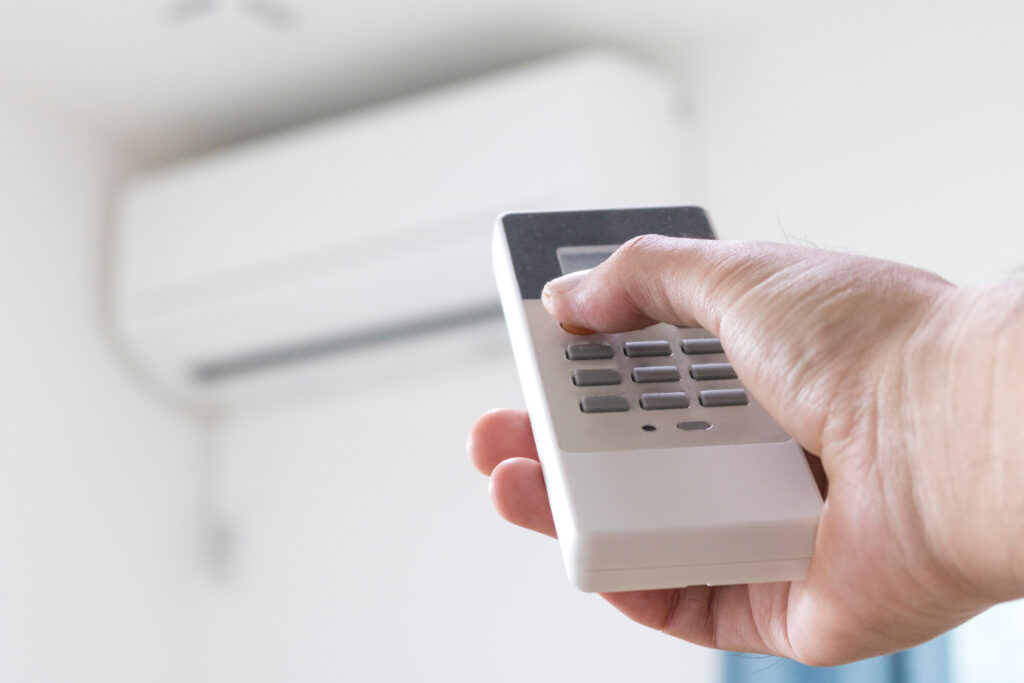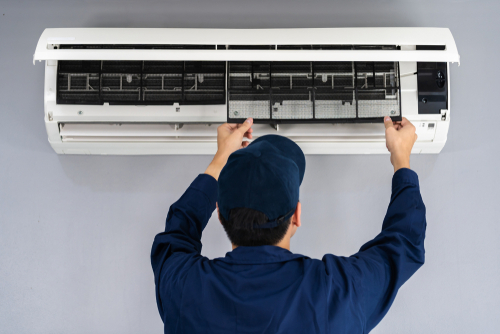Struggling to use a Japanese air conditioner? Check out this ultimate guide on how to use Japanese air conditioners like a pro. This guide to using Japanese air conditioners discusses the different settings on the air conditioner remote, different modes available, and also tips on how to clean the Japanese air conditioner. Read on to get the details!
Confused by Japanese AC remotes with all those buttons? Don’t sweat it! This guide cools you down on “How to Use Japanese Air Conditioners 101.” Learn about modes, temperature control, and airflow settings. Get ready to conquer the climate and achieve maximum comfort in your Japanese home!
Here’s a quick glance on Japanese AC remote symbols and it’s meaning and translation:
| Power On/Off運転・停止 unten/teishi | Look for 運転・停止 button to turn the AC on or off respectively. You’ll easily find this button cause it’s bigger than the other buttons and almost always in a different color. |
| Change Mode運転切換unten kirikae | There are five modes in a typical Japanese AC. Look for 運転切換 button to change the mode. Check out the five modes: |
| Automatic自動 (jidô) | In Automatic mode 自動, will maintain appropriate temperature. |
| Heat暖房 (danbô) | 暖房 heat mode uses hot air to maintain the set temperature. |
| Cool冷房 (reibô) | In Cool mode, the unit will only use cool air to maintain the set temperature. |
| Fan送風 (sôfû) | In Fan mode, the unit will only use fan to blow air |
| 不在ECO/エコEco | Use this button to conserve energy and be eco friendly. |
| Dehumidifier除湿/ドライ (joshitsu/dry) | If you want to dehumidify a room then select 除湿/ドライ. This will not change the temperature but only dehumidify the room. This is especially useful during the rainy season. |
| Fan Speed風量切換 (Fûryou kirikae) | If you want to change the fan speed of the AC look for 風量切換. There are 4 speeds available. |
| High Speed強風 (kyôfû) | |
| Low Speed微風 (bifû) | |
| Medium Speed弱風 (jakufû) | |
| Automatic自動 (jidô) | |
| Fan Direction風向 (kazamuki) | If you want to change the direction of the airflow then look for 風向 button. |
| Noise Suppression静か (shizuka) | Some ACs might have a white noise setting 静か that can help you drown out other noises. |
| Timerタイマー (taimaa) | The Timer allows the unit to be programmed to run for a specific amount of time before shutting off. Depending on the type of unit, there are several possible options for how to program the timer. |
| Swingスイング | Look for スイング button to turn on the swing so that fan direction is constantly moving. |
| Change Time時間変更 (jikan henkô) | You can set the time to shut off the AC by using this setting |
| On/Off入・切 (ireru/kiru) | Use this button 入・切 to turn the time on or off, respectively. |
Page Contents
How to use Japanese Air Conditioners?
The air-conditioning unit is known as “air-con” in Japan. The remote, on the other hand, is known as “rimo-con”.


If you live in a furnished apartment that already has an air-con installed and if you cannot find the remote control, it might be mounted on the wall near the air-conditioner.
If you cannot see it, it is probably hidden behind the curtain.
Most of the remote controls of Japanese air conditioners have the same basic functions. You can look at any remote and you will find that they all have similar functions.
While the buttons of different remotes may not be at the exact same place, they all work similarly.
If you get confused, just look closely at the kanji characters. You may also notice that remote controls of some higher-end air-conditioners have additional functions.
These extra functions are not explained in this guide. The additional settings that you may find in some remotes include an on-off timer, self-cleaning setting, and clothes drying setting.
- Related: How to use Japanese washing machines
- Related: Japanese for washing machines and dryers
How to On/Off Japanese air conditioner
The most important function of a Japanese air conditioner’s remote control is the ‘on/off’ button.
The on/off button is written as 運転/停止 and it pronounced as unten/teishi. These words mean operation/suspension.
This button, in several remote controls, may also be labeled as 運転切/入 or just 切/入. By pressing this button once, you can turn the air-conditioner on.
When the air conditioner turns on, the little screen on the remote control comes on.
The screen displays several information such as temperature. There may also be other settings that are displayed on the screen of the remote control.
Japanese Air Conditioner Remote Control Translation
Here is a translation of some of the most common buttons on a Japanese air conditioner remote control:
- 運転 (Unten): This button turns the air conditioner on and off.
- 温度 (Ondo): This button adjusts the temperature. The up arrow will increase the temperature, and the down arrow will decrease the temperature.
- 風量 (Fuuryo): This button adjusts the fan speed. The up arrow will increase the fan speed, and the down arrow will decrease the fan speed.
- 風向 (Fukao): This button adjusts the direction of the airflow. The up arrow will point the airflow up, the down arrow will point the airflow down, and the left and right arrows will point the airflow left and right.
- 運転切換 (Unten kirikae): This button changes the operating mode. The different modes are usually displayed on the screen of the remote control. Common modes include:
- 冷房 (Reibo):** Cool mode
- 暖房 (Danbou):** Heat mode
- 除湿 (Josetsu):** Dehumidify mode
- 送風 (Soupuu):** Fan only mode
- タイマー (Taameer): This button sets a timer for the air conditioner to turn off.
- 清浄 (Seijo): This button turns on the air purifier function.
- 切 (Kiri): This button cancels the current setting.
- 取消 (Torikesh): This button clears the timer setting.
How to change the temperature using Japanese air conditioner remote
This is probably the easiet setting to find on the remote of a Japanese air conditioner. The “change temperature” buttons are marked on the remote in the shape of an up and down arrow.

There may also be remote controls that have this setting marked as the plus or minus sign. In kanji, this setting is marked as 温度, which is pronounced as ondo, and it means temperature. You can press the up arrow or the plus signt to increase the temperature.
Similarly, to decrease the temperature, you can press the down arrow or the minus sign.
How to choose between the different Modes available on the Japanese air conditioner remote?
There are several remote controls that display the type of modes on the screen. This may include auto-run, heating, cooling, etc.
When you press the button that is labeled as 運転切換, the little arrow on the screen will go down and point to a different modes.
This button is known as unten kirikae, and it means ‘change mode’. With the help of this one button, you can change the mode of your air conditioner.
You will notice that many leopalace remote controls have this function.
Now, there are also other remote controls that do not have this ‘change mode’ on the screen. Instead, there will be buttons in the remote control that are labeled with the name of the type of modes. In this case, you can simply press the button labeled with the mode you want your air conditioner to perform.
The following are some of the standard opertions that are included in many Japanese air-conditioners:
Types of mode in Japanese air-conditioners:
- 自動 (auto-run, “jidou“)
- 冷房 (cooling, “reibou“)
- 除湿 (de-humidifier, “joshitsu“)
- 送風 (ventilator that dries inside of a/c to prevent mold, “soufu“)
- 暖房 (heater, “danbou“)
- 省エネ (low power-usage, “shou ene“)
- 暖房 (warming, for warm air, “danbou”)
- 自動 (to set the temperature and fan speed of the air conditioner automatically according to the room temperature, jidou)
- 停止 (stop. teishi)
- 温度, also indicated as 温度↑ (to adjust temperature, ondo)
- 風量 (to control the strength or weakness of wind, fuuryou)
- 風向 (helps adjust the angle of the wind, fuukou)
- 取消 (to cancel, torikeshi)
- 送風 (helps use the conditioner as a fan, soukou)
There are many Japanese air conditioners that have many different additional functions, but these are the most basic functions that are found in all remote controls. These are also the types of operations that are most commonly used.
How do I set the timer on my aircon in Japan?
To set the timer on your AC in Japan look for this symbol [入り / いり / iri; it may also be タイマー / たいまー / taima-]. You can set the timer to turn the AC between 1 to 12 hours later. Use the up and down arrows to select the number of hours.
What temperature should I set for the AC in Japan?
The recommended temperature for setting your AC in Japan is 28 degrees Celsius (82.4 degrees Fahrenheit). This is the default temperature setting for air conditioners in Japan, and it is designed to be comfortable and energy-efficient.
There are a few reasons why 28 degrees Celsius is the recommended temperature for AC in Japan.
First, the average temperature in Japan during the summer is around 30 degrees Celsius (86 degrees Fahrenheit). Setting your AC to 28 degrees Celsius will still allow you to cool down and be comfortable, without running up your energy bill.
Second, setting your AC to 28 degrees Celsius helps to reduce the risk of heatstroke. Heatstroke is a serious medical condition that can occur when the body’s temperature gets too high.
By setting your AC to 28 degrees Celsius, you can help to prevent heatstroke and keep yourself safe.
Finally, setting your AC to 28 degrees Celsius is good for the environment. When you set your AC to a lower temperature, it uses more energy.
This can contribute to climate change. By setting your AC to 28 degrees Celsius, you can help to reduce your carbon footprint and protect the environment.
Of course, the ideal temperature for your AC will vary depending on your personal preferences and the specific conditions in your home.
If you are feeling cold, you can always adjust the temperature up a few degrees. However, it is generally recommended to keep your AC set to 28 degrees Celsius or higher.
Useful Modes On Japanese Air Conditioners
Day Out Mode
This mode is indicated in the remote as おでかけ and it is pronounced as odek ake. This mode is used to help keep the temperature of the room constant when you are going out.
Energy Efficient Mode
This mode is referred in the remote as 省エネ, which is pronounced as shou ene. This mode in the remote control is used to reduce the energy consumption of your air conditioner when it is in use.
Ionizer Mode
This mode is referred in the remote control as Ion and it is used to release positive and negative ions. By doing this, this mode helps to reduce smells and gather house dust, pollen, and other particles.
Laundry Mode
This mode is known as randori in Japanese, and it is labeled in the remote control as ランドリ. This is a very special mode because it helps you to dry all your clothes indoor. This is a mode that is best used when you are not at home and cannot control the temperature.
Cleaning Your Japanese Air Conditioner
You should clean the filter of your air conditioner every three months. The newer models comes with a self-cleaning function. This function can be activated with the help of your remote control.
Even with the self-cleaning function, it is advisable to do a manual clean up of the unit. This helps to prevent the buildup of mold, dust, and bacteria.

Also, if you notice a weird or unusual smell coming from your air conditioner, you must clean the unit immediately.
If you cannot do it yourself, contact your repairman and get your unit cleaned as the smell may be a sign that there is a buildup of mold in your unit.
How to clean your Japanese air conditioner?
- Before you begin the task of cleaning up your air conditioner, make sure that you are wearing your gloves, face mask, and goggles.
- It is a good idea to keep yourself protected when you are working on the cleanliness of your air conditioner.
- When beginning to clean, make sure you have your vacuum cleaner and additional plastic bags with you.
- Remove any furniture that is around or place a tarp over all large items.
- Make sure to put a plastic bag underneath the air conditioner to catch dust. Open all the windows in the room to let the air circulate.
- Turn off the power, unplug the air conditioner, and open the cover. You may want to use a vacuum cleaner with a brush attachment to clean the unit. Remove the filter very gently.
- Keep the filter inside a plastic bag and use the vacuum cleaner to clean off all excess dust from the filter.
- When you are done doing this, use a showerhead or a hose to clean the filter thoroughly. Make sure that when you are cleaning the filter, you spray water on the exterior.
- Let the filter air dry for at least 24 hours or until the filter is completely dry. When the filter is completely dry, you can insert it back on.
- You should never use a damp filter as this can result in a buildup of mold.
- You also need to clean the air conditioner from the outside using a damp cloth. Simply wipe the exterior gently.
Some tips on how to use Japanese air conditioner
- During the rainy season, you should use the dehumidifying function in your air conditioner. However, in the summer months, you should use the cooling function.
- When you return home on a hot summer day, use the fan mode.
- You can pair your air conditioner with a fan to distribute cool air all across the room. It also helps in reducing energy consumption.
How can I save money on my AC in Japan?
Here are some tips on how to save money on AC in Japan:
- Turn the circulator on along with the AC and turn it upwards
- Clean the air filters regularly so the AC works efficiently
- During winter in Japan, keep the temperature at 20℃ in the Summer and in the winter at 28℃
- Keep the auto run on, so the AC will start only when needed
- If you turn on the AC let it run for a while do not turn it in a short amount of time cause most of the power is used in the first 30 – 45 minutes of turning the AC on
- During the summer season, keep the blinds closed to keep hot rays out so the room cools faster. During the winter, if you’re using the warming option then keep the bind open so that whatever little sunshine does appear enters the room.
The final word…
I hope you found this guide helpful. You can now navigate through your Japanese air conditioner in a breeze with the help of this guide. So, are you ready to bring home a new Japanese air conditioner for the summer months.




